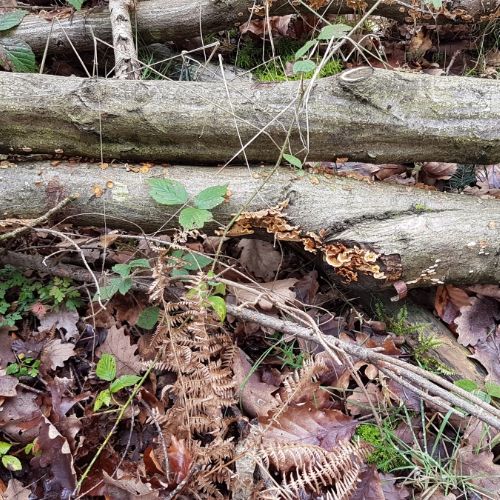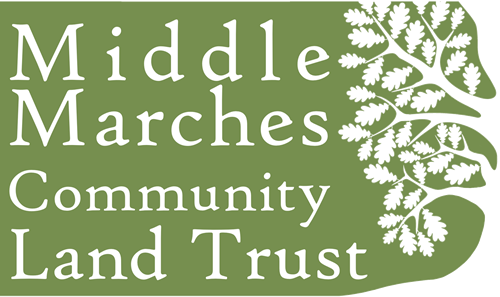Woodland Walk at Horderley
Saturday 22nd February 2020
On Saturday 22nd February, a group of 27 met at The Plough Inn in Craven Arms to begin our Woodland Walk with forester, Richard Craven. We carpooled up to the woodland entrance, about a mile away from the pub, and gathered round to hear about Richard’s involvement as woodland manager.
Richard Craven, woodland manager talking to the group

The woodland, spanning just shy of 100 acres, was felled after the war in 1947 and replanted with a mix of species, including hornbeam. Richard opened the talk by explaining the difference between a continuous cover and clear-felled system, giving examples of the positives and negatives of each.
The clear-felled system, which is the most common in the UK, follows this pattern:
-
Start with bare ground;
-
manage by thinning;
-
clear-fell when the trees are mature;
-
start the process again.
The main advantage of this system is that it is easy to manage. However, you have to be careful with creating a monoculture system because where there is only one species, it is vulnerable to disease. Secondly, with little light reaching the forest floor due to the closed canopy system, wildlife habitats are poor. Thirdly, when the trees are felled and you are back to bare ground, the risks of run-off, erosion and flooding dramatically increase.
With continuous cover, you may be starting with bare ground if starting from scratch, but the thinning regime is different. What’s important here is that you are encouraging light onto the ground, which in turn stimulates growth and natural regeneration occurs. The aim is to thin in different stages to create several layers of canopy and create a new opportunity for wildlife as opposed to damaging the habitat.
We were very lucky to be joined by Caroline Uff from the National Trust, who gave examples of invertebrates (silver-washed fritillary butterflies, white-letter hairstreak butterflies) that will thrive in a mixed, well-structured woodland where light is reaching the forest floor and there is improved ground flora.
The difficulty with the continuous cover system is that it is harder to manage. There are always trees in the way of what you want to do! Not to mention the problem of deer and squirrel damage, which were frequent topics of conversation throughout the morning.
We then moved on to look at part of the woodland which was a mix of planted trees and natural regeneration.
Native woodland, unmanaged

These were all native and had had no management whatsoever. Being native species, this is not a problem as they will manage themselves in almost any situation. However, when looking to the forest floor it was bare (in terms of flora). You can imagine how dark it would be when the trees are out in leaf, so there is little chance of anything surviving at this level. Richard is hoping to thin this piece of woodland to improve this. The hazel understory is a great habitat for dormice, but hazel thrives and fruits better where there is a more open canopy (such as the final area we looked at). Caroline showed us how to identify dormouse signs by looking at nuts they’d nibbled!
The nut at the top of the triangle is definitely a dormouse as it has a perfectly smooth excavation

Richard is also hoping to attract pine marten (we saw a nest box in one of the trees but unfortunately none have set up home there yet). The main reason for this is to control grey squirrel. Pine marten will either prey on them or simply scare them away. Dave Pearce, a local bird expert, is currently running a pine marten project so if you are interested in finding out more, please contact him on 0779118088.
On our way to the next section of woodland, we saw fox gloves coming through. This is an example of a plant that has responded to light reaching the forest floor as it wasn’t there last year. We also saw some wonderful fungi with local expert, Rob Rowe. These included blushing bracket, scarlet elf cup (left) and hairy curtain crust (right).
Scarlet Elf Cup Fungi

Hairy Curtain Crust Fungi

The stand you see in the next photo was thinned nine years ago. It has the makings of a successful second story. One of the problems now is the roe deer that are present, which weren’t around when it was thinned. Richard acknowledged that fencing is the only real solution to keeping the deer out but the sheer cost of erecting and maintaining it would not be feasible. We also touched on the idea of introducing wild boar, but after Richard explained the rate at which they reproduce, the group was swiftly put off the idea!
Thinned nine years ago

We saw lots of grand fir. Richard will continue to thin this to encourage regeneration. We also learned that in woodland, it is best for wildlife if approximately 30% is deadwood, which ideally would be a mix of standing and fallen deadwood.
The final part of the walk looked at a piece of mixed-species woodland with oak, hornbeam, beech and ash, and an understory of hazel, ash, beech and oak. Richard explained that this is what one should hope to achieve after twenty years of management.
Managed woodland

This piece will now look after itself for another fifteen-twenty years before it needs to be thinned again. If it were a coniferous plantation left unmanaged, it would become very dark and dense over the same period and would eventually fall down.
We would like to give special thanks to Richard Craven for hosting such a fascinating morning. Big thanks also go to our local experts Caroline Uff, Rob Rowe and Dave Pearce for their valuable contributions.
Middle Marches is run entirely voluntarily
Supporting the Trust makes a huge difference to how we operate and grow in future.Thank you for your support.
